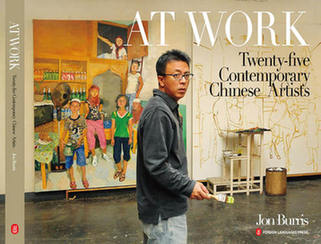ARTISTS REVISITED
ARTISTS REVISITED
By LIU FANGNIAN
|
|
At Work: Twenty-five Contemporary Chinese Artists Jon Burris 240 pages, Hard Cover US $ 90 Published in the US by Long River Press and in China by Foreign Languages Press |
When Jon Burris dropped in on a Chinese painter's studio in the early 1990s, he sighed within that the painter was probably unable to create large-scale works since the studio, in a four-story walk-up, was too small for big canvases. Back then, Chinese painters were reluctant to suggest a price for their work to this American art buyer. They just eagerly hoped to get appraised by a Western artist, and to hear the latest news from the Western art world.
In the autumn of 2009, Jon Burris revisited his old friends for a book he was preparing At Work: Twenty-five Contemporary Chinese Artists. Clearly their situation had greatly improved. Many of them owned super-large studios that were formerly factory spaces; some had sold their works for astronomical prices. As their living conditions had undergone huge changes, would their ideas have changed too? This is what the book reveals.
In At Work Jon Burris, photographer and independent curator, enters the studios of China's 25 most influential mainstream artists, observing their creative processes from the perspective of a fellow artist. Readers can see where, what and how they work in paint or other media. The artists are He Sen, Huang Gang, Ji Dachun, Lin Tianmiao, Liu Jianhua, Liu Xiaodong, Liu Ye, Qi Zhilong, Rong Rong and Inri, Shi Guorui, Su Xinping, Sui Jianguo, Wang Guangyi, Wang Huaiqing, Wang Jianwei, Wang Tiantian, Wang Youshen, Yan Ping, Yang Shaobin, Yu Hong, Yue Minjun, Zhang Huan, Zhang Xiaogang, Zhong Biao, Zhou Tiehai.
Some are major players on China's contemporary art scene; others are rising stars. The author watches them at work in their studio, seeing how they approach the act of creation, and talks with them about the past and future.
Looking back over the course of contemporary Chinese art, it's easy to see how its connection with Chinese society has developed. Its exponents have been winning the attention of the West since the 1980s and 1990s. At that time, Burris writes, collectors preferred the particular styles and superb technique of certain artists, for example Luo Zhongli, who became famous in the 1980s. But even more of them were interested in Political Pop and Cynical Realism, as exemplified by Fang Lijun, Yue Minjun and Wang Guangyi. But the artists themselves reject these labels as misinterpretations. Yue Minjun, creator of the famous "Laughing Man" series, was seen as showing a mocking attitude to reality. But as Yue tells Burris, "I don't know why they think that. My works are not mocking." Liu Xiaodong, standard-bearer of Chinese neo-realism, keeps on recording the daily conditions of ordinary people. Some artists turn to traditional Chinese culture and art to tap a deeper creative seam. This book is significant for the insights it brings into how, after more than a decade of a boom market, Chinese artists are rethinking the past and pondering their future direction.
The authority of the work is enhanced by the inclusion of many precious photographs. Some were provided by many of the artists interviewed, whilst others were taken by the author.
In recent years Foreign Languages Press has intensified its focus on modern Chinese art, as demonstrated by such publications as 798 and Contemporary Art. The Press allocated special funds to publish At Work, inviting Burris to write and illustrate the book. The exclusive material creates a fresh and attractive volume.
While the book was still in the planning stages, it came to the attention of Long River Press in San Francisco who decided to co-publish it in the U.S. It is now easily available there.
With the shrinking of cultural differences that globalization has brought the huge influence of Western culture on the rest of the world is undeniable. Traditional Chinese culture has been brought into globalization's embrace, but its vitality means it retains its independence while actually having more and more impact on world culture.
This handsome book is a window onto the thriving contemporary art scene here, to a diversity of ideas and to Chinese society's openness to artistic development. At Work is a record of the process of art's "opening up." It will be hard to find a more meticulous or insightful record of the phenomenon.
-----------------------
LIU FANGNIAN is an editor with Foreign Languages Press.
Services
Economy
- Eco-agriculture and Eco-tourism Power Nanchang’s Green Development
- Balance Environmental Protection and Economic Prosperity – Nanchang Looks to European Technology for Green Development
- Sustainable Growth Requires Wiser Energy Use
- Chinese Economy: On the Path of Scientific Development
- China's Economy over the Last Ten Years


